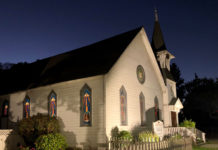I was a young kid back in the 1960s, growing up in Cupertino when it was surrounded by acres of fruit orchards and cutting ’cots (apricots) for a summer job was a rite of passage. I remember my older brothers racing home on their bikes – out of breath – after being shot at with salt pellets from a BB-gun-wielding farmer for stealing a handful of cherries. Our fertile Santa Clara Valley, filled with a profusion of spring blossoms, was dubbed the “Valley of Heart’s Delight.”
Our valley was changed forever in the late ’50s with the invention of the silicon chip. High-tech companies moved in and expanded. Our glorious orchards were replaced with rows of tract housing, business parks and shopping malls. By the 1980s, our Valley of Heart’s Delight became famously known as Silicon Valley.
But long before orchards and silicon, there were vineyards. In the late 1700s, native wild grapes were discovered and wine grapes were planted at the Santa Clara Mission. Through major setbacks such as disease (phylloxera) and prohibition, the winemakers persevered, especially in the southern area of Santa Clara Valley.
While the valley exploded with technological advances, much of our winemaking techniques were rooted in old-world traditions passed down through the generations. For example, the process of pressing juice from grapes remained relatively unchanged for centuries. But during the last several years, technology has started to catch up with the wine industry.
Dan and Therese Martin, owners of Martin Ranch Winery, recently purchased a new, state-of-the-art wine press from Italy – one of only five that are currently being used in the United States. This new press pumps nitrogen into an empty vessel, before any grapes are added, to displace and eliminate oxygen (oxygen can turn white wines brown – think of a sliced apple sitting out for a couple of hours). The nitrogen keeps the wine from discoloring and at the same time reduces the loss of aromatics (aromas) which are vital to white wines. The new press also uses a “bladder press” system where gentle suction, instead of pressure, separates the juice from the seeds. Suction is less likely to break open the seeds, which contain tannins, making the wine less astringent and smoother tasting.
Dan and Therese used their new press for 20 different wines during our last harvest and early tastings predict outstanding wines. The aromatics of the white wines have been significantly increased and the red wines are less tannic.
“Our Petite Sirah has a great bouquet and a lot going on besides high tannins – it is the best one we’ve ever done,” Dan said. “And we’re excited to release our Sauvignon Blanc and Riesling some time mid-summer.”
Other wineries, such as Jason-Stephens and Sarah’s, are using air pressure technology to gently de-stem and sort the grapes, allowing the berry to remain whole during fermentation. There aren’t any crushed or cracked seeds to dump more astringent tannins into the wine – again, producing softer wines with more varietal character.
The use of technology is taking center stage at most of our wineries and being used in every aspect of wine making – from growing better grapes to getting the wine in your glass.
Co-owner of Lightheart Cellars and President of the Wineries of Santa Clara Valley Sheldon Haynie said, “Although our wineries are thriving and winning awards around the world, we are about 10 years behind in the use of technology. We want to take advantage of our high-tech heritage to improve our winemaking.”
To improve vineyard management across all our local vineyards, Haynie is pushing to use remote sensor technology to gather data about regional air temperatures.
“If we know the seasonal accumulated degree days, we can better target harvest, and to a lesser extent irrigation,” he said. “As we know the variations between vineyards, we can prune to achieve better uniformity, and lessen frost risks. It’s a multi-year project that will map the local climate to a 100-meter scale.”
For the first time ever, a chair of technology, Tim Slater (owner of Sarah’s Vineyard), has been appointed to help advance technology within the wine association.
The Valley of Heart’s Delight has blended well with Silicon Valley. With technology and a little more aging, our wineries are blossoming.
Solis Winery: Merlot Madness: Taste a vertical line-up of vintage, award-winning Merlots, March 9 & 10, Noon – 4:30 p.m., $10/pp.
Fortino Winery: Girls Night Out, Mardi Gras theme, $25/per person includes two drink tickets, light appetizers and dessert, Friday, March 15, 7 to 9:30 p.m.
Sarah’s Vineyard: “It’s Good to be Green” cooking class, Saturday, March 16, 6 to 8 p.m.
Satori Cellars: Bat Day: A presentation and fund raiser for the Bat Conservancy of Coastal California, Saturday, March 16.
Passport Weekend: March 25-26. Tickets are $30/per person. Buy tickets at any local winery.







